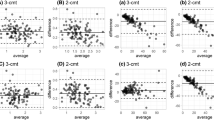Abstract
The aim of the present work was to evaluate two classical formulae allowing the correction for having neglected the first exponential in the slope-intercept method used for the determination of EDTA clearance, namely the Chantler’s linear correction formula (CH) and the Bröchner-Mortensen’s quadratic correction formula (BM). First, a comparison study was performed with the two correction formulae, in order to predict the behavior of the calculated clearance, for various levels of renal function. Second, using data obtained from 47 adult patients with normal renal function, the results obtained with the two correction formulae have been compared to the reference technique, namely the biexponential fit. The results of the comparison study indicated that for clearance values lower than 120 ml/min, the results obtained using CH were systematically lower than those of BM, whereas for clearance values between 120 and 140 ml/min, the reverse was observed. The differences however, never exceeded 8 ml/min. The results were quite different when the clearance was higher than 140 ml/min, when the difference between CH and BM results increased rapidly, and the BM provided values systematically lower than CH. The clinical study showed that, in the range of normal clearance values, both CH and BM clearances were slightly lower than the results obtained by means of the reference technique. Based on these results, a new specifically designed validation study involving patients with high clearance values is mandatory to determine which of these two correction methods is more accurate, or to devise a better correction formula.
Similar content being viewed by others
References
Piciotto G, Cacace G, Cesena P, Mosso R, Ropolo R, De Filippi PG. Estimation of chromium-51 ethylene diamine tetra-acetic plasma clearance: a comparative assessment of simplified techniques.Eur J Nucl Med 1992; 19:30–35.
Chantier C, Garnett S, Parsons V, Veall N. Glomerular filtration rate measurement in man by the single injection method using Cr-51 EDTA.Clin Sci 1969; 37:169–180.
Bröchner-Mortensen J. Routine methods and their reliability for assessment of glomerular filtration rate in adults.Dan Med Bull 1978; 25:181–202.
Chantier C, Barratt TM. Estimation of glomerular filtration rate from plasma clearance of Cr-51 edetic acid.Arch Dis Child 1972; 47:613–617.
Bröchner-Mortensen J, Haahr J, Christoffersen J. A simplified method for accurate assessment of the glomerular filtration rate in children.Scand J Clin Lab Invest 1974; 33:139–143.
Blaufox MD, Aurell M, Bubeck B, Fommei E, Piepsz A, Russel CD, et al. Report of the Radionuclides in Nephro-urology Committee on Renal Clearance.J Nucl Med 1996; 37:1883–1890.
Bland JM, Altman DG. Statistical methods for assessing between two methods of clinical measurement.Lancet 1986; 11:307–310.
Author information
Authors and Affiliations
Corresponding author
Rights and permissions
About this article
Cite this article
De Sadeleer, C., Piepsz, A. & Ham, H.R. Correction factors after having neglected the first exponential in the estimation of chromium-51 EDTA clearance: a reappraisal. Ann Nucl Med 20, 95–98 (2006). https://doi.org/10.1007/BF02985620
Received:
Revised:
Issue Date:
DOI: https://doi.org/10.1007/BF02985620




